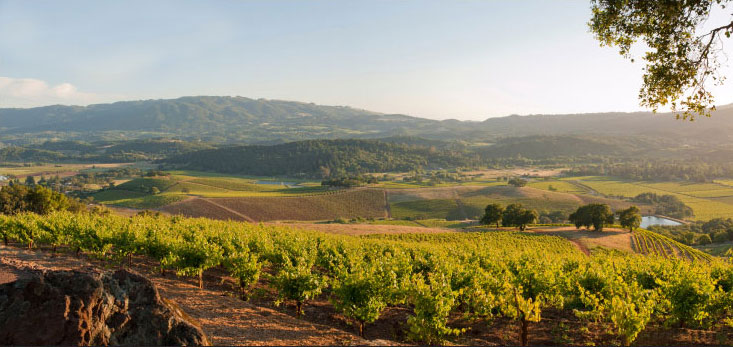A History of Sonoma’s People & Landmarks
The town of 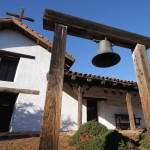 Sonoma was settled in 1823 when missionary Padre Jose Altimira of Spain founded The Mission San Francisco Solano de Sonoma, or Sonoma Mission for short. It is the last and northernmost of the 21 Franciscan missions along the California Coast.
Sonoma was settled in 1823 when missionary Padre Jose Altimira of Spain founded The Mission San Francisco Solano de Sonoma, or Sonoma Mission for short. It is the last and northernmost of the 21 Franciscan missions along the California Coast.
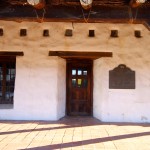
But Sonoma Valley was inhabited by Native American tribes long before the Spanish influence began. Those tribes included the Coastal Miwoks, the Pomos and the Wintuns and interesting artifacts of are on display in local museums today.
The Mexican regime dubbed the mission natives “Neophytes”, or “Mission Indians”. When Altimira’s neophytes rebelled and burned the new mission’s wooden buildings during an uprising, he became discouraged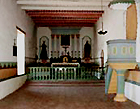 and returned to Spain. Fr. Buenaventura Fortuny from Mission San Jose replaced Altimira and the building of the mission was completed. By 1832 it had 27 rooms in the priest’s quarters, a great adobe church at the east end, and a wooden storehouse at the west end. In the courtyard were workshops where the local natives learned crafts and farming skills. There were also orchards, gardens, vineyards, fields of grain, a gristmill, housing for the soldiers, the natives, and their families, a jail, a cemetery and an infirmary. In 1834 the Mexican Congress decided to halt the mission projects. Under orders from M. G. Vallejo, the Sonoma Mission became a parish church serving Sonoma Valley until it was sold in 1881. The church and padres’ quarters were then used as a hay barn, winery and blacksmith shop. In 1903 the Historic Landmarks League purchased and rescued the mission. Full restoration began in 1911.
and returned to Spain. Fr. Buenaventura Fortuny from Mission San Jose replaced Altimira and the building of the mission was completed. By 1832 it had 27 rooms in the priest’s quarters, a great adobe church at the east end, and a wooden storehouse at the west end. In the courtyard were workshops where the local natives learned crafts and farming skills. There were also orchards, gardens, vineyards, fields of grain, a gristmill, housing for the soldiers, the natives, and their families, a jail, a cemetery and an infirmary. In 1834 the Mexican Congress decided to halt the mission projects. Under orders from M. G. Vallejo, the Sonoma Mission became a parish church serving Sonoma Valley until it was sold in 1881. The church and padres’ quarters were then used as a hay barn, winery and blacksmith shop. In 1903 the Historic Landmarks League purchased and rescued the mission. Full restoration began in 1911.
The So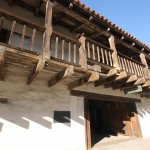 noma Barracks. General M. G. Vallejo built the Sonoma Barracks in 1836 to house Mexican soldiers. Over one hundred military expeditions sought to subdue the Wappos, Cainameros, or Satisyomis natives who attempted to throw off Mexican domination of the Sonoma area. Actual construction of the adobe barracks building most likely took place in stages and was more or less completed in 1841.In 1846 the Sonoma Barracks became the headquarters of the Bear Flag Party, which in June 1846 proclaimed a ‘California Republic’ and raised the Bear Flag in revolt. Today you can visit the Barracks dormitory which is furnished just as it would have been in the 1840’s. It’s right across the street from the Mission on the northeast corner of the Plaza.
noma Barracks. General M. G. Vallejo built the Sonoma Barracks in 1836 to house Mexican soldiers. Over one hundred military expeditions sought to subdue the Wappos, Cainameros, or Satisyomis natives who attempted to throw off Mexican domination of the Sonoma area. Actual construction of the adobe barracks building most likely took place in stages and was more or less completed in 1841.In 1846 the Sonoma Barracks became the headquarters of the Bear Flag Party, which in June 1846 proclaimed a ‘California Republic’ and raised the Bear Flag in revolt. Today you can visit the Barracks dormitory which is furnished just as it would have been in the 1840’s. It’s right across the street from the Mission on the northeast corner of the Plaza.
Tosca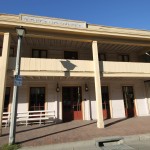 no Hotel. On the north side of the Plaza, next to the Sonoma Barracks, is the Toscano Hotel. Built in the 1850s it was first home to a retail store and rental library. Later the building was used as an inexpensive hotel, dubbed the “Eureka Hotel”. Around 1890, many patrons were Italian immigrants, and the name of the hotel changed from “Eureka” to “Toscano.” Today, the Toscano is furnished with period furniture and looks much the way it did around the turn of the century. The kitchen and dining room are located in a separate building behind the main hotel.( In the picture above it is the yellow building in the background.) Both are open to the public Saturdays, Sundays and Mondays from 1pm to 4pm and guided tours are hosted by docents in period costume.
no Hotel. On the north side of the Plaza, next to the Sonoma Barracks, is the Toscano Hotel. Built in the 1850s it was first home to a retail store and rental library. Later the building was used as an inexpensive hotel, dubbed the “Eureka Hotel”. Around 1890, many patrons were Italian immigrants, and the name of the hotel changed from “Eureka” to “Toscano.” Today, the Toscano is furnished with period furniture and looks much the way it did around the turn of the century. The kitchen and dining room are located in a separate building behind the main hotel.( In the picture above it is the yellow building in the background.) Both are open to the public Saturdays, Sundays and Mondays from 1pm to 4pm and guided tours are hosted by docents in period costume.
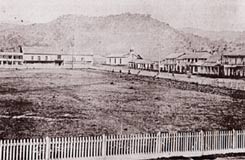 The Sonoma Plaza is the old town square and the largest of its kind in California. The Plaza’s eight acres and the surrounding street grid were laid out by General Mariano Guadelupe Vallejo in 1836, turning Sonoma from a mission town to a Mexican style pueblo. He built the barracks for Mexican army troops at the northeast corner of the plaza across the street from the Sonoma Mission, and his family’s first Sonoma home, La Casa Grande, on the west side. For a short time, Sonoma was the center of traffic and trade north of San Francisco. Today the Plaza is lined with charming shops, popular restaurants and Sonoma Valley agricultural specialties, including world-renowned cheeses and wines. Enjoy one of the many events held in the Plaza or relax for a picnic and visit the friendliest ducks in town.
The Sonoma Plaza is the old town square and the largest of its kind in California. The Plaza’s eight acres and the surrounding street grid were laid out by General Mariano Guadelupe Vallejo in 1836, turning Sonoma from a mission town to a Mexican style pueblo. He built the barracks for Mexican army troops at the northeast corner of the plaza across the street from the Sonoma Mission, and his family’s first Sonoma home, La Casa Grande, on the west side. For a short time, Sonoma was the center of traffic and trade north of San Francisco. Today the Plaza is lined with charming shops, popular restaurants and Sonoma Valley agricultural specialties, including world-renowned cheeses and wines. Enjoy one of the many events held in the Plaza or relax for a picnic and visit the friendliest ducks in town.
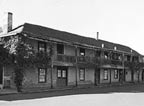 Blue Wing Inn. Just off the Sonoma Plaza across the street from the Mission is the Blue Wing Inn, the oldest adobe structure visible to the public north of the San Francisco Bay. This long, low adobe building was allegedly the first hotel north of San Francisco. It was built by General M. G. Vallejo circa 1840 to accommodate newcomers and travelers. During the California Gold Rush, the Blue Wing Inn was purchased by two retired sailors, Cooper and Spriggs, who ran it as a hotel and store. The guest list included John C. Fremont, U. S. Grant, Kit Carson, Fighting Joe Hooker, William T. Sherman, Phil Sheridan, and members of the Bear Flag party. The place was known by the locals as the Sonoma House. The second floor was built in 1849 and the name “Blue Wing” became legal record by July, 1853. It was well known by travelers on their way up the Sonoma Trail to the Trinity Mountains and the northern mining districts. The Blue Wing Inn today is a private home to those local residents who are fortunate to live with the history and an occasional ghost.
Blue Wing Inn. Just off the Sonoma Plaza across the street from the Mission is the Blue Wing Inn, the oldest adobe structure visible to the public north of the San Francisco Bay. This long, low adobe building was allegedly the first hotel north of San Francisco. It was built by General M. G. Vallejo circa 1840 to accommodate newcomers and travelers. During the California Gold Rush, the Blue Wing Inn was purchased by two retired sailors, Cooper and Spriggs, who ran it as a hotel and store. The guest list included John C. Fremont, U. S. Grant, Kit Carson, Fighting Joe Hooker, William T. Sherman, Phil Sheridan, and members of the Bear Flag party. The place was known by the locals as the Sonoma House. The second floor was built in 1849 and the name “Blue Wing” became legal record by July, 1853. It was well known by travelers on their way up the Sonoma Trail to the Trinity Mountains and the northern mining districts. The Blue Wing Inn today is a private home to those local residents who are fortunate to live with the history and an occasional ghost.
La Casa Grande. In the middle of the block on First Street West, next to the Salvador Vallejo Adobe is General Vallejo’s first home, La Casa Grande. Construction began around 1836 and completed in 1840. Eleven Vallejo children were born in the house. Over the years, La Casa Grande’s many distinguished visitors made it the center of social and political life north of San Francisco Bay. After the Bear Flag revolt, the ground floor of La Casa Grande was used as a retail store, city council chamber, and other purposes until 1854 when the entire house was turned over to the Reverend John L. Ver Mehr for use as a girls’ school. The main wing of the house was destroyed by fire on February 12, 1867, leaving only the low two-story servants’ wing which is still standing today.
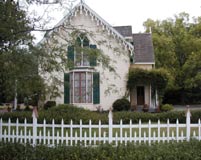 General Mariano Guadelupe Vallejo. The last home of General Mariano Guadelupe Vallejo, Sonoma’s founder, is Lachryma Montis. In the midst of the sixty acre estate was a beautiful spring that the local Native Americans had called Chiucuyem (“crying mountain”). Vallejo translated the name into Latin, “Lachryma Montis” (“mountain tear”). In 1851-52, the two story, wood frame house was designed and built on United States east coast, shipped by sail around Cape Horn and then assembled at the present site the following Spring. The style is Gothic Victorian, with a large Gothic window in the master bedroom, twin porches, dormer windows, and ornate carved wooden trim along the eaves. Bricks were placed inside the walls of the house for insulation, and each room had its own white marble fireplace. The crystal chandeliers, lace curtains, the handsome rosewood grand piano and many other furnishings were imported from Europe. Vallejo’s home once included a large barn and several houses for the working staff, several pavilions and various outbuildings. Grape vines and fruit trees were planted. The quarter-mile long driveway entrance was lined with cottonwood trees and Castilian roses.
General Mariano Guadelupe Vallejo. The last home of General Mariano Guadelupe Vallejo, Sonoma’s founder, is Lachryma Montis. In the midst of the sixty acre estate was a beautiful spring that the local Native Americans had called Chiucuyem (“crying mountain”). Vallejo translated the name into Latin, “Lachryma Montis” (“mountain tear”). In 1851-52, the two story, wood frame house was designed and built on United States east coast, shipped by sail around Cape Horn and then assembled at the present site the following Spring. The style is Gothic Victorian, with a large Gothic window in the master bedroom, twin porches, dormer windows, and ornate carved wooden trim along the eaves. Bricks were placed inside the walls of the house for insulation, and each room had its own white marble fireplace. The crystal chandeliers, lace curtains, the handsome rosewood grand piano and many other furnishings were imported from Europe. Vallejo’s home once included a large barn and several houses for the working staff, several pavilions and various outbuildings. Grape vines and fruit trees were planted. The quarter-mile long driveway entrance was lined with cottonwood trees and Castilian roses.
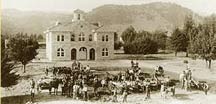 Sonoma’s City Hall. Dedicated in 1908, Sonoma’s City Hall in the center of the Plaza was originally designed with four identical facades so that merchants from any side of the square could say the City Hall faced their businesses. Made of basalt stone from local quarries, the City of Sonoma government offices still remain in this central landmark of the valley.
Sonoma’s City Hall. Dedicated in 1908, Sonoma’s City Hall in the center of the Plaza was originally designed with four identical facades so that merchants from any side of the square could say the City Hall faced their businesses. Made of basalt stone from local quarries, the City of Sonoma government offices still remain in this central landmark of the valley.
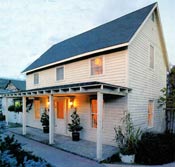 General Joseph Hooker House. The General Joseph Hooker House (formerly the Vasquez House) was built in the early 1850s for General “Fighting” Joe Hooker of Civil War fame. Joe Hooker sold the house, originally located on First Street West, and the many acres of adjoining land to Catherine Vasquez and her husband, Pedro, with the deed registered in Catherine’s name. The Vasquez family occupied the house until 1901, and it is believed that at least two of their children were born in one of the upstairs bedrooms. Located at 414 First Street East through the El Paseo walkway. The House serves as a small museum and is open Saturday, Sunday, and Monday from 1 to 4 p.m. The museum offers a Time Line of the history of Sonoma and Joseph Hooker in one room and changing photographic exhibits of Sonoma in another.
General Joseph Hooker House. The General Joseph Hooker House (formerly the Vasquez House) was built in the early 1850s for General “Fighting” Joe Hooker of Civil War fame. Joe Hooker sold the house, originally located on First Street West, and the many acres of adjoining land to Catherine Vasquez and her husband, Pedro, with the deed registered in Catherine’s name. The Vasquez family occupied the house until 1901, and it is believed that at least two of their children were born in one of the upstairs bedrooms. Located at 414 First Street East through the El Paseo walkway. The House serves as a small museum and is open Saturday, Sunday, and Monday from 1 to 4 p.m. The museum offers a Time Line of the history of Sonoma and Joseph Hooker in one room and changing photographic exhibits of Sonoma in another.
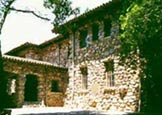 Jack London State Historic Park. About 40 acres of famous author, Jack London’s original 1,400-acre Beauty Ranch was acquired by the state. The original park included London’s grave, the ruins of Wolf House, and Charmian London’s House of Happy Walls. Over the years additional acreage has been added. Today the park contains more than 800 acres, including several of the ranch buildings and the cottage where London produced much of his later work. A three-quarter mile walk takes visitors to a dam, lake, and bathhouse built by London. Other hikes lead up through fir and oak woodlands to views of the Valley of the Moon. Another trail leads to Jack London’s grave and to the ruins of the “Wolf House,” London’s dream house, which was destroyed by fire in 1913.
Jack London State Historic Park. About 40 acres of famous author, Jack London’s original 1,400-acre Beauty Ranch was acquired by the state. The original park included London’s grave, the ruins of Wolf House, and Charmian London’s House of Happy Walls. Over the years additional acreage has been added. Today the park contains more than 800 acres, including several of the ranch buildings and the cottage where London produced much of his later work. A three-quarter mile walk takes visitors to a dam, lake, and bathhouse built by London. Other hikes lead up through fir and oak woodlands to views of the Valley of the Moon. Another trail leads to Jack London’s grave and to the ruins of the “Wolf House,” London’s dream house, which was destroyed by fire in 1913.

